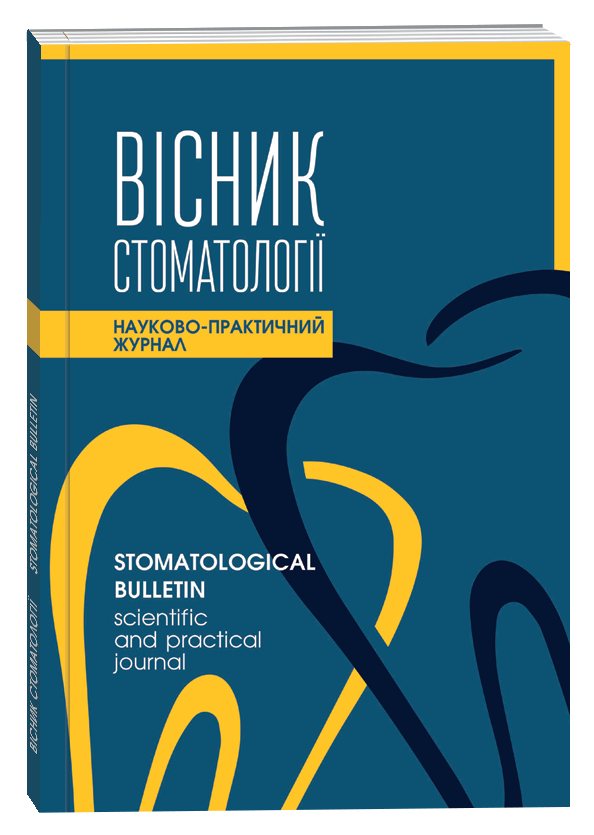MANUFACTURING TECHNOLOGY AND CLINICAL APPLICATION OF BIOINERT CERAMIC INSERTS WITH ZIRCONIUM OXIDE
DOI:
https://doi.org/10.35220/2078-8916-2022-44-2.19Keywords:
bioinert ceramic insert, zirconium oxide, dental microprosthesis, intradermal implantationAbstract
The aim of the study. Experimental studies on the degree of influence on the surrounding tissues during implantation of samples of the main materials used for the manufacture of bioinert ceramic inserts in the clinic. In order to improve the method of manufacturing dental prostheses based on frameless ceramics, research was conducted on improving the edge fit, increasing the strength of the connection of the facing layer, which are the main direction in improving the inertness, strength and aesthetics of inlays during prosthetics. The conducted studies showed that there is also a need to study the bioinertness of the inlay material, which significantly distinguishes ceramic inlays from other designs that can be applied in similar clinical situations. Research materials and methods. A morphological study of the skin of white Wistar rats was carried out after intradermal implantation of Weron 99, Wirocer, Wirobond, IPS e.max Press ceramics. During the experiment, the animals were kept in the conditions and on the diet of the vivarium in accordance with the prescribed normative data. Experiments with animals were conducted according to established rules for working with them. Scientific novelty. The conducted research was aimed at improving the technique of manufacturing hip ceramic inserts using frameless ceramics. Studies have shown that unidirectional dystrophic changes in the epithelium and dermis of the skin of experimental animals during intradermal implantation of alloys: Weron 99, Werocer, Wirobond and IPS e.max Press ceramics are expressed to a lesser extent, which indicates a more significant bioinertness of ceramics when implanted in the tissues of the oral cavity . The result of experimental and bench research was an improved method of manufacturing a hip pressed insert. Conclusions. The conducted studies showed high inertness and structural strength of the material of the tabs, which gives grounds for their use in clinical practice.
References
Рosterior implant single-tooth replacement and status of adjacent teeth during a 10-year period: a retrospective report. / С.Е. Мisch, F. Мisch-Dietsh, J. Silc, E. Barboza, L.J. Cianciola, C. Kazol. Регiodontol. 2008. №. 79(12). Р. 2378-2382.
Магнуссон А.-Н. Эстетические цельнокерамические реставрации для передних зубов. Новое в стоматологии. 2005. №4. С 25-39.
Профилактика различных осложнений при ортопедическом лечении включенных одиночных дефектов зубных рядов. / В.В. Лепский, О.В. Деньга, Т.Г. Вербицкая, О. А. Макаренко. Вісник стоматології. 2012. № 1. С. 53-57.
Influence of Resin Cements and Aging on the Fracture Resistance of IPS e.max Press Posterior Crowns. / М.М. Abou-Madina, M. Ozcan, K.M. Abdelasis. Int. J. Prosthodont. 2012. №.25(1). Р. 33-35.
Сеramco 3 margin and opaque correction liquid - жидкость для плечевой массы, корректора опака и много другого. / Р. Кузьмиченко, М. Таранько. Зубное протезирование. 2010. № 3. С. 19-23.
Филиппенкова Л. Практическое применение диоксида циркония NexxZr. Зубное протезирование. 2012. № 1. С. 40-43.
Meta-analysis of fixed partial denture survival: рprostheses and abutments / M.S. Scurria, J.D. Bader, D.A. Shegars. J. Prosthet.Dent. 1998. N. 79. Р. 459-464.
Influence of cooling rate on zirconia veneer interfacial adhesion / G. Gostemeyer, M. Jendras, M.P. Dittmer, [et al.] Acta Biomater. 2010. № 6. Р. 4532-4538.









